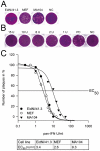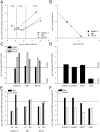Type I interferon reaction to viral infection in interferon-competent, immortalized cell lines from the African fruit bat Eidolon helvum
- PMID: 22140523
- PMCID: PMC3227611
- DOI: 10.1371/journal.pone.0028131
Type I interferon reaction to viral infection in interferon-competent, immortalized cell lines from the African fruit bat Eidolon helvum
Abstract
Bats harbor several highly pathogenic zoonotic viruses including Rabies, Marburg, and henipaviruses, without overt clinical symptoms in the animals. It has been suspected that bats might have evolved particularly effective mechanisms to suppress viral replication. Here, we investigated interferon (IFN) response, -induction, -secretion and -signaling in epithelial-like cells of the relevant and abundant African fruit bat species, Eidolon helvum (E. helvum). Immortalized cell lines were generated; their potential to induce and react on IFN was confirmed, and biological assays were adapted to application in bat cell cultures, enabling comparison of landmark IFN properties with that of common mammalian cell lines. E. helvum cells were fully capable of reacting to viral and artificial IFN stimuli. E. helvum cells showed highest IFN mRNA induction, highly productive IFN protein secretion, and evidence of efficient IFN stimulated gene induction. In an Alphavirus infection model, O'nyong-nyong virus exhibited strong IFN induction but evaded the IFN response by translational rather than transcriptional shutoff, similar to other Alphavirus infections. These novel IFN-competent cell lines will allow comparative research on zoonotic, bat-borne viruses in order to model mechanisms of viral maintenance and emergence in bat reservoirs.
Conflict of interest statement
Figures







Similar articles
-
Reduced IFN-ß inhibitory activity of Lagos bat virus phosphoproteins in human compared to Eidolon helvum bat cells.PLoS One. 2022 Mar 8;17(3):e0264450. doi: 10.1371/journal.pone.0264450. eCollection 2022. PLoS One. 2022. PMID: 35259191 Free PMC article.
-
Henipavirus neutralising antibodies in an isolated island population of African fruit bats.PLoS One. 2012;7(1):e30346. doi: 10.1371/journal.pone.0030346. Epub 2012 Jan 12. PLoS One. 2012. PMID: 22253928 Free PMC article.
-
Type III IFNs in pteropid bats: differential expression patterns provide evidence for distinct roles in antiviral immunity.J Immunol. 2011 Mar 1;186(5):3138-47. doi: 10.4049/jimmunol.1003115. Epub 2011 Jan 28. J Immunol. 2011. PMID: 21278349 Free PMC article.
-
Henipaviruses at the Interface Between Bats, Livestock and Human Population in Africa.Vector Borne Zoonotic Dis. 2019 Jul;19(7):455-465. doi: 10.1089/vbz.2018.2365. Epub 2019 Apr 13. Vector Borne Zoonotic Dis. 2019. PMID: 30985268 Review.
-
Public health awareness of emerging zoonotic viruses of bats: a European perspective.Vector Borne Zoonotic Dis. 2006 Winter;6(4):315-24. doi: 10.1089/vbz.2006.6.315. Vector Borne Zoonotic Dis. 2006. PMID: 17187565 Review.
Cited by
-
Functional properties and genetic relatedness of the fusion and hemagglutinin-neuraminidase proteins of a mumps virus-like bat virus.J Virol. 2015 Apr;89(8):4539-48. doi: 10.1128/JVI.03693-14. Epub 2015 Mar 4. J Virol. 2015. PMID: 25741010 Free PMC article.
-
The Egyptian Rousette Genome Reveals Unexpected Features of Bat Antiviral Immunity.Cell. 2018 May 17;173(5):1098-1110.e18. doi: 10.1016/j.cell.2018.03.070. Epub 2018 Apr 26. Cell. 2018. PMID: 29706541 Free PMC article.
-
Glycoproteins of Predicted Amphibian and Reptile Lyssaviruses Can Mediate Infection of Mammalian and Reptile Cells.Viruses. 2021 Aug 30;13(9):1726. doi: 10.3390/v13091726. Viruses. 2021. PMID: 34578307 Free PMC article.
-
The Glycoproteins of All Filovirus Species Use the Same Host Factors for Entry into Bat and Human Cells but Entry Efficiency Is Species Dependent.PLoS One. 2016 Feb 22;11(2):e0149651. doi: 10.1371/journal.pone.0149651. eCollection 2016. PLoS One. 2016. PMID: 26901159 Free PMC article.
-
Middle East respiratory syndrome coronavirus accessory protein 4a is a type I interferon antagonist.J Virol. 2013 Nov;87(22):12489-95. doi: 10.1128/JVI.01845-13. Epub 2013 Sep 11. J Virol. 2013. PMID: 24027320 Free PMC article.
References
-
- Simmons NB. Evolution. An Eocene big bang for bats. Science. 2005;307:527–528. - PubMed
-
- Teeling EC, Springer MS, Madsen O, Bates P, O'Brien S J, et al. A molecular phylogeny for bats illuminates biogeography and the fossil record. Science. 2005;307:580–584. - PubMed
-
- Jones G, Teeling EC. The evolution of echolocation in bats. Trends in Ecology & Evolution. 2006;21:149–156. - PubMed
Publication types
MeSH terms
Substances
LinkOut - more resources
Full Text Sources
Research Materials

